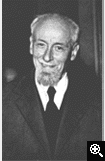|
|
|
| |
| |
Eligio Perucca
| |
 |
|
was born in 1890 in Potenza. When he was 20 years only, he graduated in Physics at the University of Pisa.
In 1911 Perucca became assistant of professor Naccari at the Physic Institute of the University of Turin.
In 1922 Perucca succeeded the professor Quintino Majorana to the chair of Experimental Physics of the Politecnico di Torino.
At the Politecnico the physicist taught from 1922 to 1960.
In 1911 Perucca started his studies on the staus of the polarisation of the light and in 1913 he manufactured a penumbra electricity analiser, known as Bilamina of Bravais-Perucca, even to-day not revalled for its precision.
Perucca applied to study Volta' effect, of which he could measure the value related to many pairs of metals with a metrologist like precision, even if he worked under experimental conditions. Then he could correlate Volta's effect to Peltier's effect, the photoelectric effect to the thermoelectric effect.
In 1928 Perucca discovered that Fermi's theory on free electrons in metals gave an exhaustive explanation of relationships between constants of the photoelectric effect and thermionic effect and costants of Volta's and Peltier's effects.
In 1930 he discovered the photoelectric effect of contact or of the barring layer and he manufactured a new type of electrometer, known as Perruca's Electrometer, that gathered high sensibility and small electrical capacity properties.
Perucca was rector of the Politecnico from 1947 to 1955. During these years, he devoted to rebuild the whole university complex, destroyed during the last world war, paying a particular attention to the Institute of Physics, whose laboratory had been equipped by him. In 1959 Perucca personally cared for the transfer of his laboratory from Valentino Castle to the new head office of Corso Duca degli Abruzzi. Besides being the rector, Perucca was also the dean of the Academy of Sciences of Turin, deputy-president of the National Academy of Lincei, Italian Member for the Union of Pure and Applied Physics, in the Cnr's committee.
He died on 5th January 1965 in Rome.
|
| |
|
|

